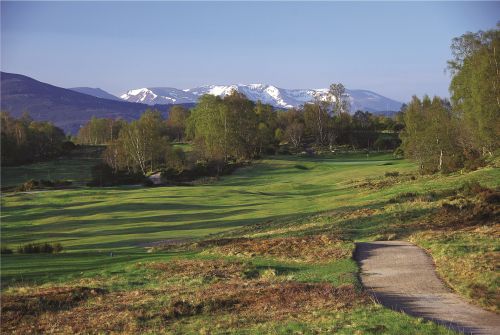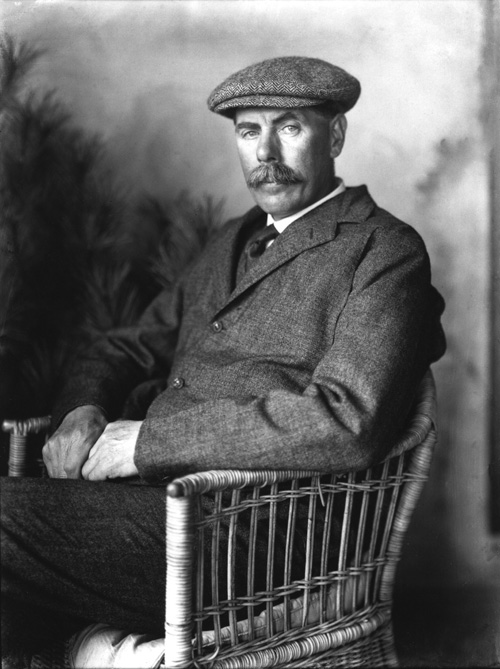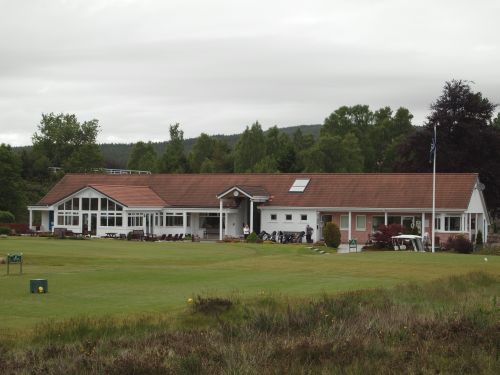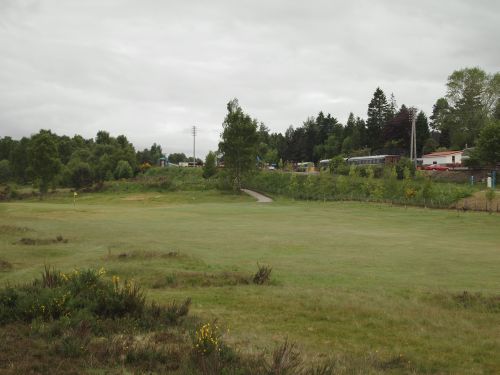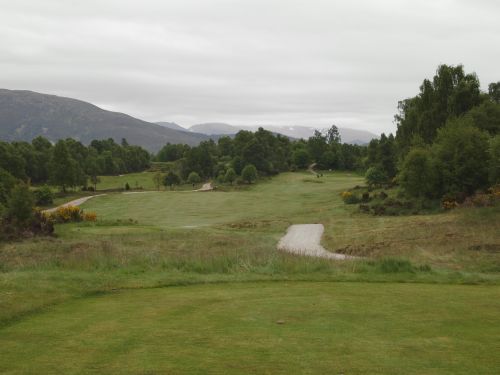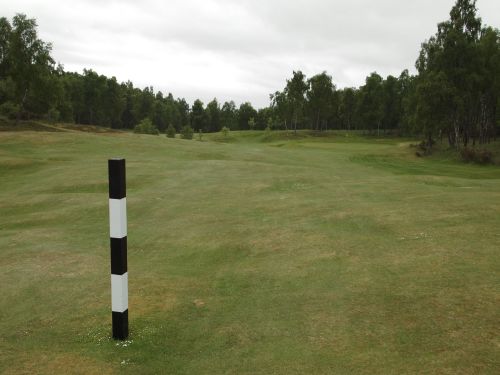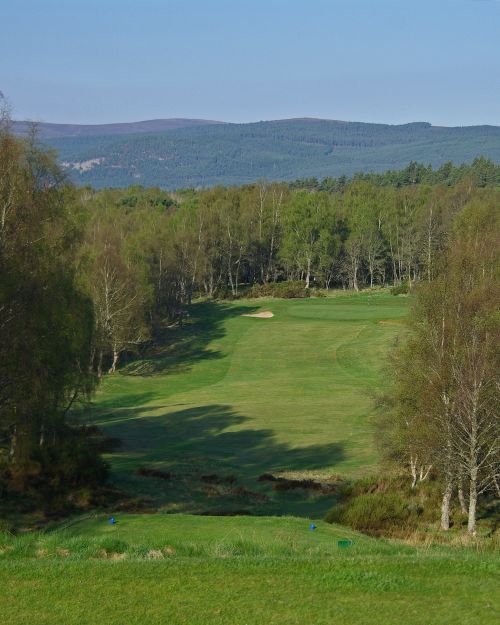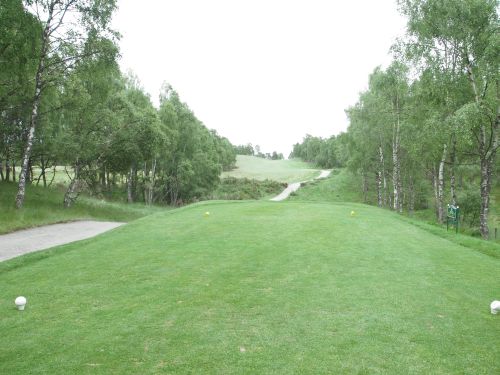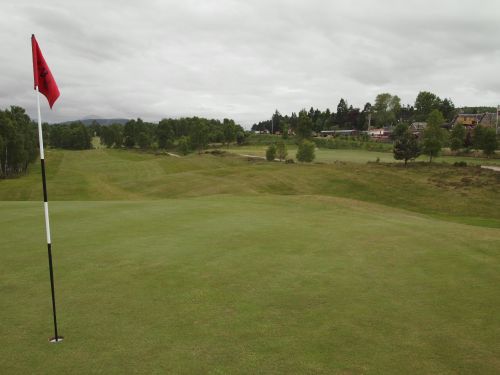It speaks volumes for the respect a golf club enjoys that it can be known in shortened terms.
The splendid Boat of Garten course, some 25 miles or so south of Inverness in Scotland, is one such course.
And rather than refer to it by its full and proper name, the Boat of Garten Golf and Tennis Club, I’m going to join those who refer to this James Braid gem simply as ‘The Boat’.
‘The Boat’ gets its name not from a boat or ship but a chain ferry that used the cross the Spey River joining the towns of Abernethy and Duthil.
Ironically, the founding of ‘The Boat’ club in 1898 coincided with the opening of a new bridge over the Sprey and the discontinuation of the ferry.
The club itself was founded on April 9th, 1898 when a dozen people, including local businessmen, hoteliers, farmers, railwaymen, a policeman and Kincardine church minister, Rev. Duncan agreed to create a golf course.
Annual subs were set at the princely sum of 2s 6p.
However this was some 30 years before Braid agreed to stamp his fingerprint at ‘The Boat’.
Within five months of that first club meeting six holes had been laid out for the pleasure of members, and flicking through the pages of the Club’s Centenary year book there’s a description by the late Donald Robertson, one of the club’s noted historians, describing how those six holes came about.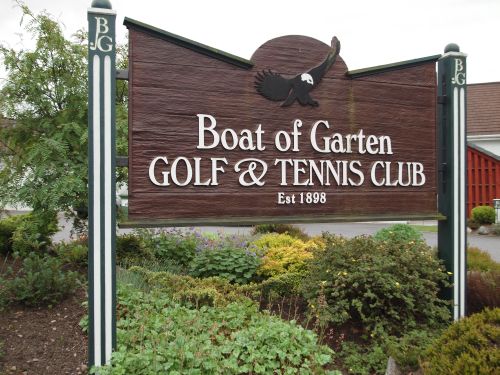
“If we draw a line from the railway signal cabin nearest Aviemore to the centre of Ann Bisset’s hill (adjacent to the present 17th green), then follow the enclosure fence back to the 15th tee, then turn right and walk straight for the railway line keeping the Craig Rock in view, that almost square area provided the six holes’.
‘The Boat’s’ official opening took place on 25th August, 1898.
It wasn’t till another 10 years that work began on extending the course to eight holes while the building of a new clubhouse was undertaken to replace the small hut.
Fast forward to 1930 and the committee of day, despite the world being gripped by depression, finally began talking seriously of developing ‘The Boat’ into an 18 hole challenge.
Discussions got under way with a local farmer while an approach was also made, through the Dalmahoy Club in Edinburgh, to invite Braid, then a five-time British Open champion and now professional at Walton Heath in Surrey, to travel north to Scotland with a view of designing the course that now greets golfers.
But it wasn’t as simple as Braid being met at the station and shown around the intended area of design.
Robertson recalled that Braid, accompanied by his secretary, arrived at ‘The Boat’ without any prior notice for what was virtually a recognisance patrol not only of ‘The Boat’ but also to assess the economic worth of the fledging town and surrounding areas.
Having designed such gems as the Kings and Queens courses at Gleneagles, upgrading at Carnoustie, Downfield, Fortrose and Rosemarkie, Brora, Dalmahoy, Murcar, Royal Musselburgh and Scottscraig, it seemed Braid was not all together certain ‘The Boat’ could afford his services.
When Braid finally got to see the club’s ‘books’ he is believed to have remarked: “Lo and behold there was enough money for three golf courses’.
Braid went to work on 43 new acres of land loaned to the club for an agreed annual rent of £15 with the cost of the design and golf course building project coming in around £1,000.
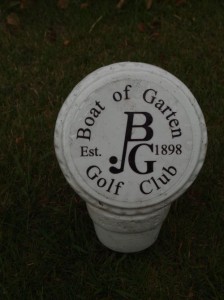 Given that Braid and his team did not have access to present day machinery the new course amazingly was completed within a year of Braid commencing work.
Given that Braid and his team did not have access to present day machinery the new course amazingly was completed within a year of Braid commencing work.
In fact, the course was ready for play on Saturday 23rd July, 1932 and given a foursomes match had been a feature of Saturday’s, so it was a foursomes match that first took to the new Braid-designed 18-holer.
The official opening took place a fortnight later on 6th August, 1932 with Benjamin Mitchell Graham, ‘a generous benefactor to the club’, invited to hit the first tee shot.
The local Strathsprey Herald covered the official opening and reported: “Mr Graham drove off. Longer shots have been seen, but it sufficed. And the caddie who retrieved the ball was suitably rewarded”.
Despite Graham failing to impress one local reporter, his memory lives on with staging each of the Mitchell Graham Quaich, and presented annually to the winner of Men’s Handicap Match Play.
In 1933, Hugh Macdonald, one of five brothers, won the inaugural Mitchell Graham Quaich and apart from no competition in the period 1940 to 1945 inclusive because of WW11, the trophy remains one of the most sought after among ‘The Boat’ members.
The Sangster Trophy, or Boat Open as it more well known today, is the club’s premier event.
It was first played in 1937 with the trophy presented in July that year by Miss Bella Sangster. Miss Sangster along with her sister, Agnes and their mother and step-father, were among those who attended the founding meeting some 30 years earlier.
Dr. Tom Paterson, representing Glasgow University, won the inaugural Sangster Trophy or Boat Open along with a silver plated tee service and canteen of cutlery.
It was not to 1958 that I.M. Anderson became the first ‘Boat’ member to win the Boat Open.
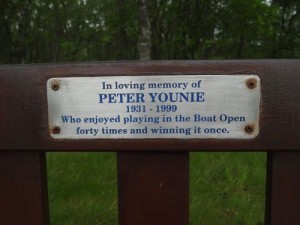 There has been some alterations and modifications to Braid’s original design with the most notable work carried out on ‘Tulloch’, and what was originally the par four, 13th.
There has been some alterations and modifications to Braid’s original design with the most notable work carried out on ‘Tulloch’, and what was originally the par four, 13th.
The Club’s Centenary yearbook describes the 13th as such: “This, for years, incorporated the Boat’s original ‘thrombosis slope’ but recent development of a new green has taken the string out of the final ascent. It remains, however, a severe par 4 for most club golfers.
So rare is a ‘lucky’ eagle at the 13th that the effort of Ewan Mitchell in 1995, when he hit driver and 7-iron for this rare bird, even gets a mention in the centenary publication.
The remodelling of the 13th became such an important chapter in the history of ‘The Boat’ that on 1st June, 1991 a new mixed foursomes event was inaugurated that continues to be played each year – the 13th Hole Trophy.
It wasn’t to 2005 the 13th was made into its present par five, and it’s the club’s No. 1 stroke index hole measuring 473-yards off the back tee. 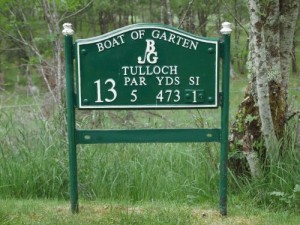
So with 18 wonderful holes dominated in the distance by the spectacular Cairngorm Mountains, and such distinctive features as Lairig Ghru and the northern corries of Braeriach, what more could members desire.
Well most importantly there was one overriding necessity and that was full ownership of their golf course!
That finally came about in 1991 and seven year before the club’s 100th birthday with the purchase of the course from Reidhaven Estates.
Negotiations to ‘buy’ their course had been ongoing for many years in correspondence and formal discussions before the price was put at £65,000, and with the Club’s committee agreeing to the deal on 10th October, 1990.
So eventually on 31st May, 1991 the club and members could proudly boast full ownership of ‘The Boat’.
(Firstly, a word of advice. If you are playing ‘The Boat’ for a first time grab a yardage book as it will surely save you a few shots and a lot of guess work.)
Like most towns, Boat of Garten grew from its connection with the railway.
Unfortunately, the cost of up-keeping Scotland’s vast rail network spelt the death knell to many wonderful rail lines and not just the line running through Boat of Garten.
Gone but not forgotten are other rail reminders linked to golf courses in Britain, and none more so than at the Home of Golf.
St. Andrews townsfork and visitors alike still enter the ancient town through the remnants of a rail cutting that ran down to sheds where the Old Course Hotel and Spa now today stands.
However on a visit to ‘The Boat’ we were reminded of seemingly ancient era of steam rail travel just as we were making our way to the first tee.
Nearing the Boat of Garten station, lying just a half-wedge shot to the right side of the first green, was one of the Strathsprey steam locomotives.
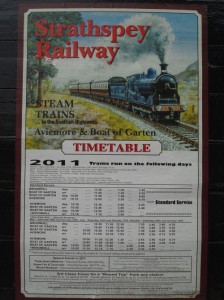 First there was the sound of the whistle and then the sight of an old steam-puffing locomotive pulling into the station that just seem to make the journey out onto ‘The Boat’ that more exciting.
First there was the sound of the whistle and then the sight of an old steam-puffing locomotive pulling into the station that just seem to make the journey out onto ‘The Boat’ that more exciting.
The railway runs from Broomhill via Boat of Garten and onto Aviemore in the south, and services are in operation from March through to October though there is a special ‘Santa’s Express’ and ‘Mince Pie Specials’ in December.
The rail line virtually runs parallel for the opening four holes with just a wire fence separating the course from the tracks.
And in a continuing rail theme, making your way about the ‘The Boat’ is very much about staying on track. Get off line and your game quickly goes off the rails.
As early as the second hole, any shot right and you’re among birch, broom and heather.
Then at the par third, a super par three running from left to right behind the second green, you’ll end up in a deep gully with any shot leaking right.
The fourth is a little akin to the second. The majority of the trouble is on the right with the favoured shot to a landing area left that opens up the uphill green.
Until the remodelling of the 13th, the fourth used to be ‘The Boat’s’ only par five.
There’s a black-and-while marked post in the middle of the fourth fairway showing the line before finding your way to superb green.
This hole is Braid at his best.
The fifth, an uphill and not too difficult par four, takes you back in the general direction of clubhouse but don’t for a minute think you’re in for any respite as ‘The Boat’ is about to take you on a ride down troughs and over peaks, testing your courage off the tee and your eagerness to tackle various challenges.
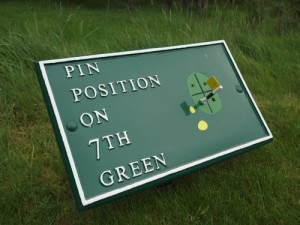 The 386-yard par four seventh is an example but take a note of the tee position marker before tee off.
The 386-yard par four seventh is an example but take a note of the tee position marker before tee off.
This uphill hole requires a blind second shot over the brow of the hill to and unsited green. Local knowledge is the key here, and a hole aptly named ‘Bell’.
But there is two bells, a man’s size ship’s bell at the back of the green for the gentleman to ring when they leave the green, and a second on the red tee at the eighth for the ladies to sound as a courtesy for those behind.
The outward nine ends with a 154-yard par three named Beag that’s Gaelic for little or wee. On a day when the winds got its dander up, the ninth can easily be a wee shocker.
‘The Boat’s’ homeward stretch starts with a 271-yard par four and a good chance for a birdie. Grab it if you can because it might be a good few holes before you’ll get another opportunity.
The 11th and 12th holes demand straightness and while Braid was thrilled with the backdrop, don’t get carried with the expanse of the Cairngorm vista, as the 12th is much akin to threading a needle.
Now we come to the 13th!
For those contesting the annual ‘13th Hole Trophy’ here’s a hole that will either bring you luck or turn your outing decidedly unlucky. It’s uphill all the way and requires three mighty blows to get to the green in regulation.
Some of the sting has been taken out of this hole with some levelling of the ‘thrombosis slope’ but for those ringing the bell as you head to the next tee, it’s very much either a case of a point’s victory over this brute or a card-destroying knockout.
Here’s a hole that’s 307-yards off the back tees and with a variety of options.
You can play short of the gully but that leaves you a long second shot to the green or if you take on the gully there’s the reward of a shorter club, maybe even a wedge, if the conditions are in your favour. It’s definitely a hole where a stroke saver is helpful or playing alongside a member.
But then if you were like the author, it was a shot out of the depth of the gully and the hope I’d found the green with my next.
The 16th is a super par three, and regarded by many members as one of the best holes of the course. Named Craigowrie, it measures 168-yards with the big test here not to be short or left that will find more broom and heather and then a blind shot over a bunker.
Two holes to play and both heading for home.
Probably for one of the only a few occasions at ‘The Boat’ you stand on the raised 17th tee looking down on a fairway with some sense of authority over the course.
Named Bisset’s Hill, and measuring 344-yards off the back or 314-yards off the yellow, here’s a good chance to sneak in one last birdie before the final hole. The ideal approach is down the left side and thus avoiding a bunker on the right side of the green.
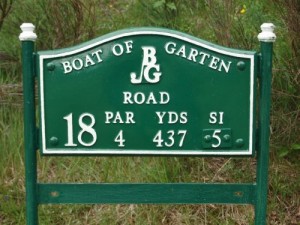 While the 13th is ranked the No. 1, ‘The Boat’ has seemed to have saved the hardest to last, and asking more final question of your golf game.
While the 13th is ranked the No. 1, ‘The Boat’ has seemed to have saved the hardest to last, and asking more final question of your golf game.
The 18th measures 437-yards off the white and 426-yards off the yellow. It’s the longest par four on the course, and nearly 30-yards longer than its closest rival, the sixth.
Having found the final fairway the next test before finding safe harbour in the clubhouse is to get your second to stop on a raised green.
That done your journey around ‘The Boat’ is over.
Just as a journey on the Strathsprey Railway is a journey back in time so too is the experience of playing ‘The Boat’.
Despite the advances in the equipment, and the ridiculous introduction of yardage measurement devices, here is a golf course that still meets the golfing challenges of the a new Millennium.
And 80 years after Braid laid out his design, ‘The Boat’ continues to pitch and roll, asking members and visitors alike to hit the fairways, find the greens and hole the putts.
So step aboard for one of golf’s great cruises.
BOAT OF GARTEN – 7 THINGS TO BOOST YOUR KNOWLEDGE
1. The first hole was renamed ‘John’s View’ in memory of former long-time club professional, John Grant or ‘Jock the Pro’ as he was affectionately known. Grant served as the club’s pro from 1951 to he passed away twenty years later.
2. One of the most sought after trophies is the ‘13th Hole Trophy’ that is presented each year to the winners of the mixed foursomes. James Gourlay, a former Vice-President and Greens Convenor, marked the completion in the 1980s of the new 13th hole by donating the trophy. The 13th hole, at 432-yards off the medal tee is the toughest par four on the course.
3. ‘Pricey’ was a dog owned by Miss Blackwood, who worked during World War 11 in Winston Churchill’s Cabinet office. Miss Blackwood didn’t play golf but the club in a rare honour by any golf club bestowed membership on Pricey so he could walk the course with her.
4. And if a dog could be granted membership then the courtesy of the course could be extended to one of Britain’s pioneer aviators, and it was not to play golf. Scotland-born Jim Mollison was granted permission in 1931 to land his aircraft on the first fairway as part of his plans that year in flying to the north of Scotland.
5. A few years earlier, Mollison had served as an instructor with the South Australian Aero Club in Adelaide and later with Charles Kingsford Smith’s ill-fated Australian National Airways. In July-August 1931, Mollison set a then record time of eight days, 19 hours for a flight from Australia to England.
6. At the outbreak of World War 1 the course was taken over by a company of the Morayshire Volunteers. The volunteers were drilled in bayoneting and disembowelling bags of straw hung on a wooden frame below what is now the 18th.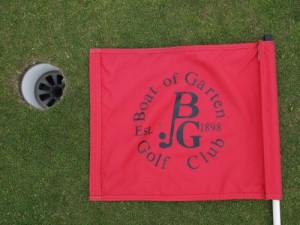
7. One of the club’s noted historians was the late Donald Robertson. Robertson had left Boat of Garten as a young man to become a police officer with the Lancashire Constabulary. In 1937, after being coached by James Braid, he won the British National Police Open with a score of 68.
